[English] 日本語
 Yorodumi
Yorodumi- PDB-2m8p: The structure of the W184AM185A mutant of the HIV-1 capsid protein -
+ Open data
Open data
- Basic information
Basic information
| Entry | Database: PDB / ID: 2m8p | ||||||
|---|---|---|---|---|---|---|---|
| Title | The structure of the W184AM185A mutant of the HIV-1 capsid protein | ||||||
 Components Components | Capsid protein p24 | ||||||
 Keywords Keywords | VIRAL PROTEIN / capsid / HIV / mutant | ||||||
| Function / homology |  Function and homology information Function and homology informationHIV-1 retropepsin / symbiont-mediated activation of host apoptosis / retroviral ribonuclease H / exoribonuclease H / exoribonuclease H activity / DNA integration / viral genome integration into host DNA / RNA-directed DNA polymerase / establishment of integrated proviral latency / RNA stem-loop binding ...HIV-1 retropepsin / symbiont-mediated activation of host apoptosis / retroviral ribonuclease H / exoribonuclease H / exoribonuclease H activity / DNA integration / viral genome integration into host DNA / RNA-directed DNA polymerase / establishment of integrated proviral latency / RNA stem-loop binding / viral penetration into host nucleus / host multivesicular body / RNA-directed DNA polymerase activity / RNA-DNA hybrid ribonuclease activity / Transferases; Transferring phosphorus-containing groups; Nucleotidyltransferases / host cell / viral nucleocapsid / DNA recombination / DNA-directed DNA polymerase / aspartic-type endopeptidase activity / Hydrolases; Acting on ester bonds / DNA-directed DNA polymerase activity / symbiont-mediated suppression of host gene expression / viral translational frameshifting / symbiont entry into host cell / lipid binding / host cell nucleus / host cell plasma membrane / virion membrane / structural molecule activity / proteolysis / DNA binding / zinc ion binding / membrane Similarity search - Function | ||||||
| Biological species |   Human immunodeficiency virus type 1 Human immunodeficiency virus type 1 | ||||||
| Method | SOLUTION NMR /  SOLUTION SCATTERING / simulated annealing SOLUTION SCATTERING / simulated annealing | ||||||
| Model details | lowest energy, model1 | ||||||
 Authors Authors | Deshmukh, L. / Schwieters, C.D. / Grishaev, A. / Clore, G. / Ghirlando, R. | ||||||
 Citation Citation |  Journal: J.Am.Chem.Soc. / Year: 2013 Journal: J.Am.Chem.Soc. / Year: 2013Title: Structure and Dynamics of Full-Length HIV-1 Capsid Protein in Solution. Authors: Deshmukh, L. / Schwieters, C.D. / Grishaev, A. / Ghirlando, R. / Baber, J.L. / Clore, G.M. | ||||||
| History |
|
- Structure visualization
Structure visualization
| Structure viewer | Molecule:  Molmil Molmil Jmol/JSmol Jmol/JSmol |
|---|
- Downloads & links
Downloads & links
- Download
Download
| PDBx/mmCIF format |  2m8p.cif.gz 2m8p.cif.gz | 6.4 MB | Display |  PDBx/mmCIF format PDBx/mmCIF format |
|---|---|---|---|---|
| PDB format |  pdb2m8p.ent.gz pdb2m8p.ent.gz | 5.5 MB | Display |  PDB format PDB format |
| PDBx/mmJSON format |  2m8p.json.gz 2m8p.json.gz | Tree view |  PDBx/mmJSON format PDBx/mmJSON format | |
| Others |  Other downloads Other downloads |
-Validation report
| Summary document |  2m8p_validation.pdf.gz 2m8p_validation.pdf.gz | 417.3 KB | Display |  wwPDB validaton report wwPDB validaton report |
|---|---|---|---|---|
| Full document |  2m8p_full_validation.pdf.gz 2m8p_full_validation.pdf.gz | 988.3 KB | Display | |
| Data in XML |  2m8p_validation.xml.gz 2m8p_validation.xml.gz | 420.7 KB | Display | |
| Data in CIF |  2m8p_validation.cif.gz 2m8p_validation.cif.gz | 474.5 KB | Display | |
| Arichive directory |  https://data.pdbj.org/pub/pdb/validation_reports/m8/2m8p https://data.pdbj.org/pub/pdb/validation_reports/m8/2m8p ftp://data.pdbj.org/pub/pdb/validation_reports/m8/2m8p ftp://data.pdbj.org/pub/pdb/validation_reports/m8/2m8p | HTTPS FTP |
-Related structure data
- Links
Links
- Assembly
Assembly
| Deposited unit | 
| |||||||||
|---|---|---|---|---|---|---|---|---|---|---|
| 1 |
| |||||||||
| NMR ensembles |
|
- Components
Components
| #1: Protein | Mass: 25455.178 Da / Num. of mol.: 1 / Mutation: W184A, M185A Source method: isolated from a genetically manipulated source Source: (gene. exp.)   Human immunodeficiency virus type 1 / Gene: gag-pol / Production host: Human immunodeficiency virus type 1 / Gene: gag-pol / Production host:  |
|---|---|
| Has protein modification | Y |
-Experimental details
-Experiment
| Experiment |
| ||||||||||||||||||||||||||||||||||||||||||||||||||||||||||||||||||||
|---|---|---|---|---|---|---|---|---|---|---|---|---|---|---|---|---|---|---|---|---|---|---|---|---|---|---|---|---|---|---|---|---|---|---|---|---|---|---|---|---|---|---|---|---|---|---|---|---|---|---|---|---|---|---|---|---|---|---|---|---|---|---|---|---|---|---|---|---|---|
| NMR experiment |
|
- Sample preparation
Sample preparation
| Details | Contents: 0.5 mM [U-13C; U-15N; U-2H] entity, 1 mM EDTA, 50 mM sodium chloride, 1 mM DTT, 20 mM sodium phosphate, 95% H2O/5% D2O Solvent system: 95% H2O/5% D2O | ||||||||||||||||||||||||
|---|---|---|---|---|---|---|---|---|---|---|---|---|---|---|---|---|---|---|---|---|---|---|---|---|---|
| Sample |
| ||||||||||||||||||||||||
| Sample conditions | pH: 6.5 / Pressure: ambient / Temperature: 308 K |
-Data collection
| NMR spectrometer |
| |||||||||||||||
|---|---|---|---|---|---|---|---|---|---|---|---|---|---|---|---|---|
| Soln scatter | Type: x-ray / Conc. range: 0.63 - 5.0 / Detector type: mosaic Gold CCD / Sample pH: 6.5 / Source beamline: 12-ID-B / Source class: synchrotron / Source type: APS / Temperature: 298 K |
- Processing
Processing
| NMR software |
| ||||||||||||||||
|---|---|---|---|---|---|---|---|---|---|---|---|---|---|---|---|---|---|
| Refinement | Method: simulated annealing / Software ordinal: 1 Details: This is an ensemble refinement. The MODEL entries appear in groups of 5, representing 20 ensembles. Xplor-NIH Ensemble Calculation This file contains 20 ensembles of size 5 Ensemble 1: MODEL ...Details: This is an ensemble refinement. The MODEL entries appear in groups of 5, representing 20 ensembles. Xplor-NIH Ensemble Calculation This file contains 20 ensembles of size 5 Ensemble 1: MODEL 1, weight: 0.379 MODEL 2, weight: 0.272 MODEL 3, weight: 0.185 MODEL 4, weight: 0.114 MODEL 5, weight: 0.050 Ensemble 2: MODEL 6, weight: 0.355 MODEL 7, weight: 0.267 MODEL 8, weight: 0.191 MODEL 9, weight: 0.126 MODEL 10, weight: 0.062 Ensemble 3: MODEL 11, weight: 0.347 MODEL 12, weight: 0.265 MODEL 13, weight: 0.193 MODEL 14, weight: 0.130 MODEL 15, weight: 0.066 Ensemble 4: MODEL 16, weight: 0.207 MODEL 17, weight: 0.205 MODEL 18, weight: 0.201 MODEL 19, weight: 0.197 MODEL 20, weight: 0.190 Ensemble 5: MODEL 21, weight: 0.221 MODEL 22, weight: 0.212 MODEL 23, weight: 0.203 MODEL 24, weight: 0.191 MODEL 25, weight: 0.173 Ensemble 6: MODEL 26, weight: 0.364 MODEL 27, weight: 0.269 MODEL 28, weight: 0.189 MODEL 29, weight: 0.121 MODEL 30, weight: 0.057 Ensemble 7: MODEL 31, weight: 0.220 MODEL 32, weight: 0.212 MODEL 33, weight: 0.203 MODEL 34, weight: 0.191 MODEL 35, weight: 0.173 Ensemble 8: MODEL 36, weight: 0.366 MODEL 37, weight: 0.269 MODEL 38, weight: 0.188 MODEL 39, weight: 0.120 MODEL 40, weight: 0.056 Ensemble 9: MODEL 41, weight: 0.219 MODEL 42, weight: 0.212 MODEL 43, weight: 0.203 MODEL 44, weight: 0.192 MODEL 45, weight: 0.174 Ensemble 10: MODEL 46, weight: 0.264 MODEL 47, weight: 0.234 MODEL 48, weight: 0.204 MODEL 49, weight: 0.172 MODEL 50, weight: 0.127 Ensemble 11: MODEL 51, weight: 0.233 MODEL 52, weight: 0.219 MODEL 53, weight: 0.204 MODEL 54, weight: 0.186 MODEL 55, weight: 0.159 Ensemble 12: MODEL 56, weight: 0.218 MODEL 57, weight: 0.211 MODEL 58, weight: 0.203 MODEL 59, weight: 0.192 MODEL 60, weight: 0.175 Ensemble 13: MODEL 61, weight: 0.096 MODEL 62, weight: 0.122 MODEL 63, weight: 0.159 MODEL 64, weight: 0.221 MODEL 65, weight: 0.403 Ensemble 14: MODEL 66, weight: 0.333 MODEL 67, weight: 0.260 MODEL 68, weight: 0.196 MODEL 69, weight: 0.137 MODEL 70, weight: 0.074 Ensemble 15: MODEL 71, weight: 0.083 MODEL 72, weight: 0.109 MODEL 73, weight: 0.149 MODEL 74, weight: 0.218 MODEL 75, weight: 0.442 Ensemble 16: MODEL 76, weight: 0.256 MODEL 77, weight: 0.231 MODEL 78, weight: 0.204 MODEL 79, weight: 0.175 MODEL 80, weight: 0.134 Ensemble 17: MODEL 81, weight: 0.298 MODEL 82, weight: 0.248 MODEL 83, weight: 0.201 MODEL 84, weight: 0.154 MODEL 85, weight: 0.098 Ensemble 18: MODEL 86, weight: 0.223 MODEL 87, weight: 0.214 MODEL 88, weight: 0.203 MODEL 89, weight: 0.190 MODEL 90, weight: 0.170 Ensemble 19: MODEL 91, weight: 0.097 MODEL 92, weight: 0.122 MODEL 93, weight: 0.159 MODEL 94, weight: 0.221 MODEL 95, weight: 0.401 Ensemble 20: MODEL 96, weight: 0.334 MODEL 97, weight: 0.261 MODEL 98, weight: 0.196 MODEL 99, weight: 0.136 MODEL 100, weight: 0.073 | ||||||||||||||||
| NMR representative | Selection criteria: lowest energy | ||||||||||||||||
| NMR ensemble | Conformer selection criteria: structures with the lowest energy Conformers calculated total number: 480 / Conformers submitted total number: 100 |
 Movie
Movie Controller
Controller





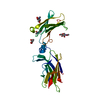

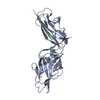
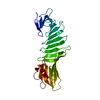
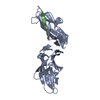

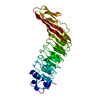


 PDBj
PDBj
